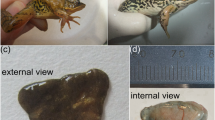Abstract
The cutaneous glands of the forehead and the metatarsus were studied by histological and histochemical methods and electron microscopy in adult male and female impalas in various seasons of the year. All glandular areas consist of apocrine and holocrine glands, which, however, occur in different proportions. Our findings in the apocrine gland cells suggest (1) the synthesis and exocytosis of a glycoproteinaceous secretory product stored in secretory granules, (2) typical apocrine secretion of the transformed apical cytoplasm, and (3) transepithelial fluid transport. The Golgi apparatus and apical membrane have binding sites for several lectins (PNA, HPA, RCA I, WGA). Cytokeratins 7, 14 and 19 are expressed at various intracellular localizations, suggesting an active role in the secretory mechanisms. The glands of the male forehead show marked seasonal changes in activity that are correlated with the main phases of the reproductive cycle, with the highest cellular activity occurring during the rut in April/May. The female forehead glands are only moderately developed and do not undergo seasonal changes. The metatarsal glands are of equal size in males and females and show no seasonal changes in activity. This study supports the hypothesis that (1) forehead glands in the male have a signaling role in the rut and (2) the metatarsal glands have a more general, probably social role maintaining and restoring contact between herd members.
Similar content being viewed by others
Author information
Authors and Affiliations
Additional information
Received: 20 October 1997 / Accepted: 17 December 1997
Rights and permissions
About this article
Cite this article
Welsch, U., van Dyk, G., Moss, D. et al. Cutaneous glands of male and female impalas (Aepyceros melampus): seasonal activity changes and secretory mechanisms. Cell Tissue Res 292, 377–394 (1998). https://doi.org/10.1007/s004410051068
Issue Date:
DOI: https://doi.org/10.1007/s004410051068




